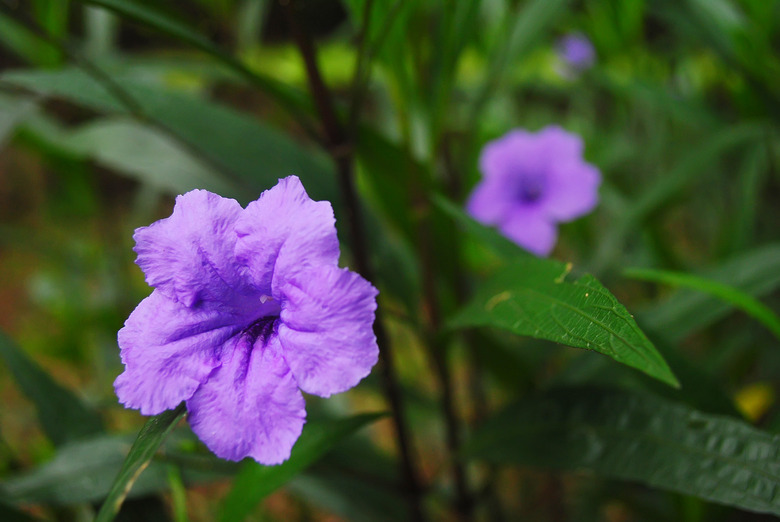How To Prune Mexican Petunias
We may receive a commission on purchases made from links.
Native to Mexico, the Mexican petunia (Ruellia simplex, U.S. Department of Agriculture plant hardiness zones 7 through 10) earns its common name from the petunialike flowers that burst into bloom almost year-round in the warmer regions of its hardiness range. It's a durable and hardy herbaceous perennial with aggressive growth that has it making the invasive plant list in areas such as Florida. Even so, it adds an attractive feel to gardens with its cheery, purplish-blue flowers atop long stems. When it comes time to prune Mexican petunias, they stand up well to hard and light trimming, which adds to its control and to the production of fuller plants.
Mexican Petunia Noteworthy Characteristics
Mexican
Petunia Noteworthy Characteristics
Evergreen Mexican petunias produce shrubby growth and multiply through underground rhizomes as well as self-seeding. Standing up to heat and humidity, cooler zones can treat them as an annual. When found in the wild, plants grow up to 4 feet tall, but those cultivated in the garden typically grow to only 2 to 3 feet tall with a similar spread.
Branches form from the ground, with long, woody stems lined in 6- to 12-inch-long willowlike, dark-green leaves sometimes tinged in purple. Mexican petunias are quite showy when in bloom, filling the garden with a sea of purplish-blue blooms. The trumpet-shaped flowers form along the top of each stem and last for a single day before dropping from the plant.
If not pruned off, small, brown, oblong seedpods form. The hard seedpods produce an audible "snap" when bursting open to release the inner seeds. Seeds fly through the air and readily self-seed throughout the landscape.
Pruning Tips for Mexican Petunias
Pruning Tips for Mexican Petunias
Pruning Mexican petunias is a suitable way to produce thicker plants and control self-seeding. For every stem you trim off, three will develop in its place, which ultimately produces more blooms and more seeds. You can prune Mexican petunias year-round but be sure to use clean pruning tool blades when making your cuts so you don't transfer a disease to the plant. A pair of hand clippers works well in making your cuts.
If your Mexican petunia suffered frost damage or you desire thicker plants, you can trim stems down to about 2 inches from the ground. Before you know it, new stems will develop and grow to a normal height. Deadheading isn't necessary, as flowers naturally self-clean, but trimming off the top of the plant where the flowers were stops the development of seeds. This helps stop the spread of unwanted plants.
Preferred Growing Conditions and Cultivars
Preferred Growing Conditions and Cultivars
Mexican petunias perform well when planted in full sun to partial shade, although more sun produces the best flowering. The plant tolerates a wide range of soil conditions, from well-draining to boggy. However, well-draining, fertile soil kept moist through regular water applications produces the best growth. The plants also grow well in pots. Make sure to use a pot with bottom drainage and use a fertile potting mix that drains well. If you live in a cold climate, you can bring pots indoors to a bright, warm location until outdoor temperatures warm in spring.
Cultivars are available that are sterile and not quite as invasive as the species. Although Ruellia simplex 'Purple Showers' (USDA zones 8-10) is sterile because it doesn't produce seeds, it still spreads by rhizomes. This cultivar produces purplish-blue flowers and grows up to 3 feet tall.
